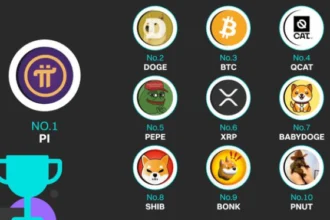The Pi Network, a mobile mining project with a massive global user base, is gearing up to launch its Open Network, marking a significant milestone in the journey toward becoming a fully operational, decentralized cryptocurrency. This eagerly awaited transition comes after years of groundwork in building an ecosystem and community centered around accessible mobile mining. As part of their preparations, the Pi Core Team has paid close attention to the successes and challenges faced by other crypto projects, especially in terms of token distribution and community engagement.
One such case is the Hamster Kombat project, a “Tap-to-Earn” cryptocurrency initiative on Telegram that recently conducted an airdrop event. While the project aimed to build enthusiasm and broaden its user base, its airdrop distribution faced several challenges. Learning from Hamster Kombat’s experience, the Pi Core Team is committed to ensuring a more equitable and transparent token distribution for the 100 billion Pi supply, aligning with their ethos of inclusivity and fair access. This article delves into how Pi Network is preparing for its Open Network launch, what lessons it has learned from Hamster Kombat’s distribution approach, and how it plans to implement a fair token distribution system for its users.
Understanding the Pi Network’s Journey to Open Network
Since its launch, Pi Network has focused on enabling people worldwide to mine its native cryptocurrency, Pi, directly from their mobile devices. Unlike traditional cryptocurrency mining that requires significant computing power, Pi’s approach has made it accessible to millions, even those without advanced technical expertise or financial resources. The community-driven project has grown rapidly, attracting users from over 230 countries and regions.
Pi Network’s ecosystem includes applications, marketplaces, and services that aim to give the Pi token real-world utility, aligning with the project’s goal of creating a decentralized, community-focused economy. Currently, Pi is in the “Enclosed Mainnet” phase, where users can trade Pi within the ecosystem but cannot yet transfer it outside the network. The upcoming transition to the Open Network phase will allow external trading, representing the project’s final step toward decentralized operations. This move will also enable Pi to be traded on crypto exchanges, making token distribution a crucial concern as the network gears up for this highly anticipated phase.
Hamster Kombat’s Airdrop: A Learning Experience for Pi Network
Hamster Kombat, a Tap-to-Earn project on Telegram, attempted to attract users by distributing free tokens through an airdrop. Tap-to-Earn, which is similar to play-to-earn models, allows users to earn tokens through engagement—in this case, tapping within the app. The concept aimed to reward users while promoting the platform.
However, the Hamster Kombat airdrop faced distribution issues, which negatively impacted user perception and engagement. The challenges were primarily related to the airdrop’s design and implementation:
- Lack of Transparency in Distribution: Hamster Kombat’s distribution process lacked transparency, with some users receiving disproportionately large amounts while others received minimal tokens. This led to frustration and allegations of favoritism, creating distrust within the community.
- Poor Allocation Strategy: The airdrop was not well-targeted. Many users who received tokens were not necessarily active or engaged with the project, resulting in a low retention rate and an ineffective distribution of tokens among genuinely interested users.
- Ineffective Anti-Sybil Measures: The airdrop faced issues with Sybil attacks, where malicious users created multiple accounts to claim tokens unfairly. This exploit not only diluted the rewards for legitimate users but also compromised the value of the tokens.
Learning from these challenges, the Pi Core Team has made transparency, fairness, and effective anti-Sybil measures central to its distribution strategy. They are committed to ensuring that Pi Network’s Open Network launch meets the expectations of a diverse, engaged, and global community.
Pi Network’s Distribution Strategy: Fairness and Transparency
The Pi Core Team recognizes that the success of the Open Network phase depends significantly on how they manage token distribution. With a total supply of 100 billion Pi, the team has committed to a fair distribution plan that aligns with the principles of inclusivity and transparency. Here’s how Pi Network is addressing the lessons learned from the Hamster Kombat airdrop:
- Balanced Token Distribution: Pi Network’s token distribution plan is designed to be inclusive, ensuring that active contributors and genuine users benefit from the token supply. This involves allocating a fair share to all miners based on their engagement and contributions over time, rather than arbitrary or favoritism-driven allocations.
- Transparent Allocation Mechanism: Transparency is a core value for the Pi Network, and the Pi Core Team is working to create a clear, well-defined allocation process. By detailing the factors influencing distribution—such as mining activity, referral contributions, and engagement in ecosystem applications—they aim to provide users with a transparent understanding of how tokens are allocated. This approach will help prevent the kind of ambiguity that led to mistrust in Hamster Kombat’s airdrop.
- Prioritizing Long-Term Community Members: To prevent issues associated with airdrops that target users who may not remain active, the Pi Core Team has devised an allocation model that rewards long-term community members and active participants. This will ensure that Pi tokens go to users who are genuinely invested in the project’s vision, helping to build a sustainable and engaged user base.
Anti-Sybil Mechanisms and Security Measures
In light of the issues Hamster Kombat faced with Sybil attacks, Pi Network has placed a strong emphasis on securing its distribution system. The team has developed several anti-Sybil mechanisms to prevent fraudulent account creation and ensure the integrity of the distribution process:
- KYC Verification: Know Your Customer (KYC) verification is central to Pi Network’s security framework. The Pi Core Team has implemented KYC checks to verify users’ identities, preventing the creation of fake accounts and ensuring that each participant is a legitimate community member.
- Multi-Factor Authentication and Account Monitoring: To further safeguard the distribution process, Pi Network uses multi-factor authentication and monitors account activity. This approach makes it difficult for malicious actors to manipulate the distribution process, ensuring a fair allocation of tokens to genuine users.
- Continuous Evaluation of Security Protocols: Security measures will be regularly assessed and updated to respond to evolving threats. By proactively identifying and addressing potential vulnerabilities, Pi Network can maintain a safe and equitable environment for its users.
Pi Network’s Commitment to Long-Term Value Creation
The Pi Core Team’s distribution strategy is designed not only to ensure fairness but also to sustain the long-term value of Pi tokens within the ecosystem. Unlike Hamster Kombat, which saw limited engagement after its airdrop, Pi Network is taking steps to foster continuous interaction within its ecosystem.
- Ecosystem Utility and Applications: One of Pi Network’s defining features is its commitment to creating real-world applications for the Pi token. With marketplaces, applications, and services within the ecosystem, Pi Network encourages users to spend and exchange Pi, promoting its utility rather than merely holding tokens as speculative assets. The team is investing in ecosystem development to ensure that Pi remains useful and valuable over the long term.
- Staking and Incentives for Holding Pi: Pi Network is considering incentives for users who choose to stake or hold their Pi tokens within the ecosystem. This approach aligns with the goal of promoting a decentralized economy where users are rewarded for their long-term commitment to the network, rather than a quick cash-out following the Open Network launch.
- Promoting Decentralized Governance: As the Pi Network grows, the Pi Core Team is also exploring decentralized governance models that will allow the community to influence the project’s direction. This would enable the community to have a say in decisions related to token allocation, ecosystem development, and other key aspects, creating a sense of ownership and responsibility among users.
Community Engagement and Transparency: Keeping Users Informed
An essential lesson from Hamster Kombat’s airdrop is the importance of clear and consistent communication with the community. The Pi Core Team recognizes that transparency and regular updates are crucial to maintaining trust and preventing misunderstandings.
- Educational Initiatives: The Pi Core Team is committed to educating users about the Open Network launch, token distribution, and security measures through blog posts, webinars, and community events. This approach ensures that users understand the value of Pi and the purpose of its ecosystem, fostering informed participation.
- Feedback Mechanisms: To strengthen community involvement, Pi Network has implemented feedback channels where users can express their views and ask questions. This feedback is taken into account in decision-making, helping the Core Team refine their approach based on community input.
- Open Communication Channels: By maintaining open lines of communication through social media, forums, and in-app announcements, Pi Network keeps users informed of developments, helping to manage expectations and build trust in the distribution process.
Preparing for the Open Network: A Fair and Transparent Future for Pi Network
As Pi Network moves closer to its Open Network launch, the Core Team is committed to making this transition as smooth and fair as possible for its users. They have demonstrated a proactive approach in learning from other projects’ experiences, such as Hamster Kombat, and in developing a robust, transparent, and inclusive distribution model.
The Pi Core Team’s emphasis on fairness, security, and community engagement sets the stage for a successful Open Network launch, positioning Pi as a viable, community-centered digital currency. By combining transparent token distribution, strong anti-Sybil protections, and meaningful user incentives, Pi Network aims to foster a sustainable ecosystem where Pi tokens have tangible value and utility.
Conclusion: A Blueprint for Equitable Token Distribution in the Crypto Space
Pi Network’s Open Network preparations show they are committed to equity, transparency and community building, this is a great case study for other blockchain projects. By learning from Hamster Kombat’s airdrop and fixing its mistakes, the Pi Core Team are showing they are proactive in making sure the distribution model is fair and sustainable. With clear comms, KYC, transparent token allocation and long term value in the ecosystem, Pi Network is setting the bar for fair token distribution.
As Pi Network gets ready for the Open Network it’s not just trying to create an inclusive and accessible digital currency but also offering a blueprint for future projects to balance community with sustainable value. Pi Network’s model says the true value of a cryptocurrency is in its real world use cases and value to the community not just in speculative trading. By reinforcing its vision of a decentralized community driven economy Pi Network is showing that digital currencies can empower everyday users and an inclusive financial system. This careful approach to token distribution, learned from past projects, is making Pi Network a pioneer in creating a fairer and more stable digital currency future. Continue Reading
















